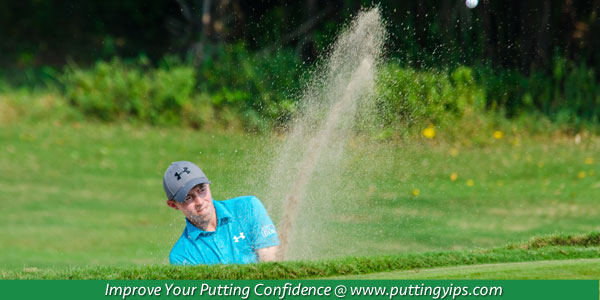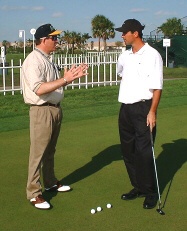
6 Habits of Highly Ineffective Putters
Ben Crenshaw, one of the best putters that ever lived, once said that “in golf, the closer you get to the hole, the more mental the game becomes.”
Putting is indeed more mental than any other part of the game because on the putting green, doubt, indecision, and fear cripple the most mentally tough golfers.
Related Article: Golfers Who Are Afraid Of Missing Putts
To put your very best, you want to be aware of the mental traps you might fall into or already engage in. These mental traps can lead to the putting yips with some golfers.
Here are the “6 Habits of Highly Ineffective Putters” based on my work with golfers that might lead to the putting yips:
(1) “Hit and Hope” Putting
Hit and hope putters lack the confidence they need to make putts. They are like the batter in baseball that hopes he won’t strike out and embarrass himself at the plate. Players who hit and hope pray their putt stops somewhere near the hole. Hit and hope putters have trouble trusting their stroke because they are so unsure of the outcome. And worst of all, hit and hope putters know they will miss–it’s just a matter of 1how much they will miss by. They just try to “get it close” so they don’t three-putt. This is a very defensive approach to putting. Great putters never hit and hope.
(2) “Do or Die” Putting
A do or die putter focuses too much on making or missing a putt. This player is consumed with outcome. This player always knows what he is putting for and what it means. If you are a do or die putter, you say to yourself “I need to make this for my par” or “If I miss this, I’ll make another bogie”. You focus on the end result–par, birdie, bogie or whatever, this causes you to forget about execution. You forget that focusing on the process is what brings good results. Do or die putting is a tense way to putt. Working the process is what helps you make putts.
(3) “Wishy-Washy” Putting
Wishy-washy putters have trouble making decisions. They change their mind often about how to hit a putt. They can’t commit to a plan! If you are a wishy-washy putter you change your mind as you try to look for breaks in the green that are not there. Now your mind is filled with doubt. The indecision kills your ability to stroke the ball with determination. It’s impossible to make an aggressive stroke because you have not committed to a plan. Indecision and doubt are a putter’s worst enemy.
(4) “Panic” Putting
Panic putters are scared to pull the putter back. Everything about putting scares them. They are so afraid to putt that they can’t see straight. Even if this player gathers himself enough to start the putter back, his muscles are too tense to make a smooth stroke. This putter is the most prone to putting yips. If you engage in this habit, you panic because putting is the weakest part of your game and you know it. You know that if you are going to score well, you need to make putts. You’ve missed too many putts in your mind and on the green to forget–too many battle scars to putt without fear.
(5) “Pessimistic” Putting
Pessimistic putters are streaky putters. They rely on momentum and results. The momentum from early putts helps a pessimistic putter continue to make them. Pessimistic putters have the ability to run the table when they get hot early. If you are a pessimistic putter and you miss early, it’s all over for you, your putting game is shot. You say thing to yourself like: “I’m going to putt poor today.” The problem is you generalize, based on the first holes, that you are not going to put well today. It’s hard for you to stay positive. Pessimistic putters are on an emotional roller coaster.
(6) “Synthetic” Putting
Synthetic putters think too much about mechanics while putting. The left-brain, the analytical side, has this putter under its spell. For the synthetic putter, putting is not natural they think too much about how to stroke the putt. They watch the putter head during the stroke and try to adjust mid stroke. If you are a synthetic putter, you are so consumed with perfect stroke path that you lose your feel and forget about the target. Synthetic putting is the opposite of “natural” putting. If you are a synthetic putter, you are also prone to getting the putting yips.
Related Golf Psychology Articles:
- Mental Coaching For Golf Yips
- Learning To Shut Off The Mental Chatter
- Six Mental Game Tips For Confident Putting
Improve Your Mental Game From Anywhere In The World

Learn how to think like a great putter and develop mental toughness with one-on-one golf psychology coaching for putting yips by mental game of golf experts at Peak Performance Sports!
You can get expert yips mental coaching with us from anywhere. Meet with us via Skype, phone, FaceTime, or GoTo Meeting. With today’s video technology, we are able to connect with athletes and coaches all over the globe.
We help golfers win at all levels including AJGA junior golfers, collegiate golfers, mini-tour golfers, Canadian Tour, PGA Tour, and LPGA Tour golfers. Find a sports psychologist near me.
Call Us Today to Schedule Your Free 15-Minute Session.
Find Out If You Can Benefit From One-on-One Mental Coaching!
888-742-7225 | 407-909-1700
